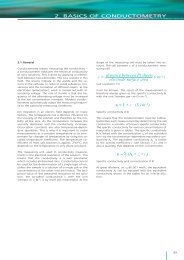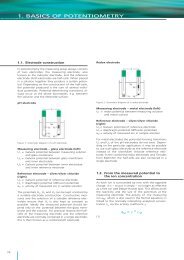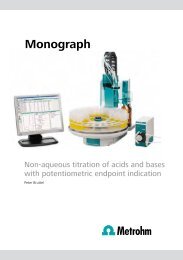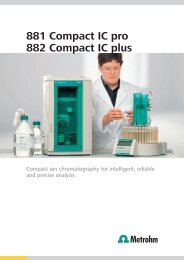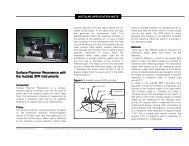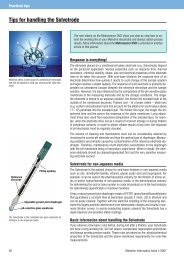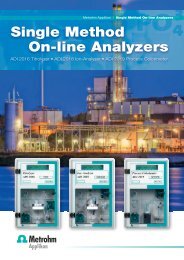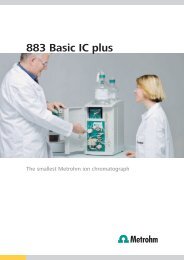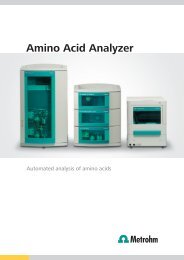Monograph - Metrohm
Monograph - Metrohm
Monograph - Metrohm
Create successful ePaper yourself
Turn your PDF publications into a flip-book with our unique Google optimized e-Paper software.
20 Practical thermometric titrimetry<br />
7. Types of thermometric titration<br />
Thermometric titrimetry can be used for the following reaction types:<br />
• Acid-base (acidimetry and alkalimetry)<br />
• Redox<br />
• Precipitation<br />
• Complexometric<br />
Because the sensor does not interact electrically or electrochemically with the solution,<br />
electrical conductance of the titrating medium is not a prerequisite for a successful determination.<br />
Titrations may be carried out in completely non-conducting, non-polar media<br />
if required. Further, titrations may be carried out in turbid solutions or even suspensions<br />
of solids. Titrations where precipitates are formed can also be carried out.<br />
7.1. Acid-base titrations<br />
7.1.1 Determination of fully dissociated acids and bases<br />
The heat of neutralization of a fully dissociated acid with a fully dissociated base (see<br />
Figure 11) is approximately –56 kJ/mol and can be calculated as a standard enthalpy of<br />
reaction using standard enthalpies of formation.<br />
H + + OH – H 2 O<br />
ΔH 0 f (kJ/mol) 0 –230.0 –285.8 ΔH 0 r = –55.8 kJ/mol<br />
Fig. 11: Titration of NaOH with<br />
1 mol/L HCl.<br />
The reaction is strongly exothermic and thus provides an excellent basis for a wide range<br />
of analyses in industry. An advantage for the industrial analyst is that the use of stronger<br />
titrants (1…2 mol/L) permits a reduction of the sample preparation effort. Samples can<br />
often be directly and accurately dispensed into the titration vessel prior to titration.




